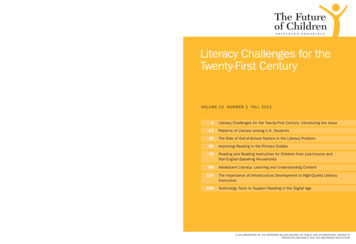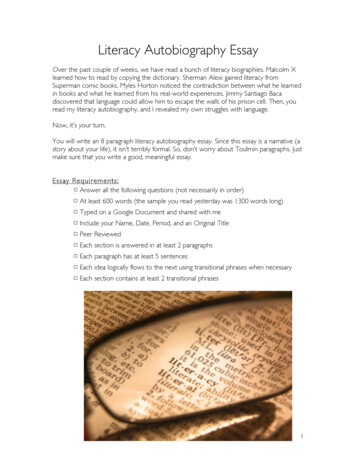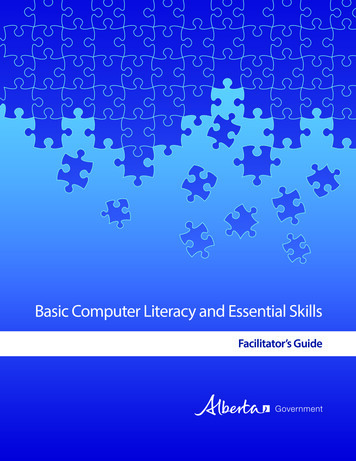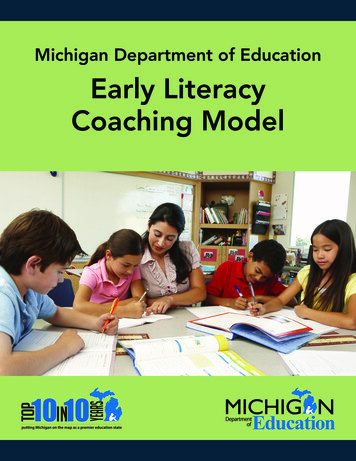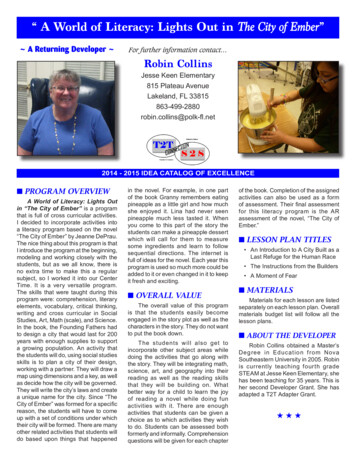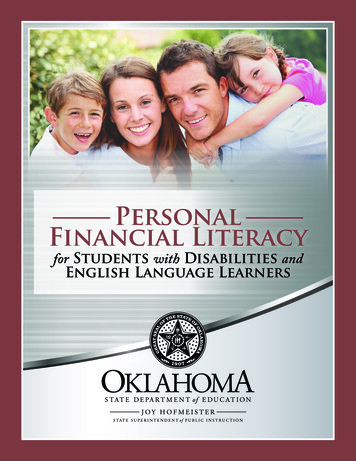
Transcription
Personal Financial Literacy Guide forStudents with Disabilities & EnglishLanguage Learners (ELL)It is the policy of the Oklahoma State Department of Education (OSDE) not to discriminate on the basis of race, color, religion, gender,national origin, age, or disability in its programs or employment practices as required by Title VI and VII of the Civil Rights Act of 1964, Title IX ofthe Education Amendments of 1972, and Section 504 of the Rehabilitation Act of 1973.Civil rights compliance inquiries related to the OSDE may be directed to the Affirmative Action Officer, Room 111,2500 North Lincoln Boulevard, Oklahoma City, Oklahoma 73105-4599, telephone number (405) 522-4930; or, the United StatesDepartment of Education’s Assistant Secretary for Civil Rights. Inquires or concerns regarding compliance with Title IX by local school districtsshould be presented to the local school district Title IX coordinator.This publication, printed by the State Department of Education Printing Services, is issued by the Oklahoma State Department of Education as authorized by 70 O.S. § 3-104. An electronic copy can be locatedon the Oklahoma State Department of Education Web site at www.ok.gov/sde. Copies have been deposited with the Publications Clearinghouse of the Oklahoma Department of Libraries. July 1, 2015Personal Financial LiteracyPage 1
IntroductionThis document has been developed to assist educators in ensuring that students with disabilities areable to demonstrate mastery of the Personal Financial Literacy (PFL) standards. All fourteen of the PFLstandards must be taught to all students, as a part of high school graduation requirements. Thesestandards of learning are priority, essential, and necessary for all Oklahoma students. Learning theideas, concepts, knowledge, and skills will enable students to implement personal financial decisionmaking skills; to become wise and knowledgeable consumers, savers, investors, users of credit, moneymanagers, and to be participating members of a global workforce and society.This document describes the PFL standards in an extended format in order to meet the needs of variouslearners, particularly students with disabilities, and English Language Learners (ELL). This documentincludes the PLF standards, extended academic goals, suggested classroom activities, and resources. TheAcademic Goals are intended to break the standards into smaller, manageable learning objectives. Theclassroom activities suggested in this document are designed to assist educators in developingappropriate activities to assist students in mastering the PFL standards. Resources to assist in theinstruction and comprehension of the standards can be found at the end of this document.House Bill 1268 has included language for students with the most significant cognitive disabilities(MSCD) and English Language Learners (ELL) to assist students in meeting the Personal Financial Literacy(PFL) graduation requirement. The changes will become effective July 1, 2015. In an effort to assistschool districts in meeting the new requirements, we have included information to assist educators inproviding appropriate instruction to meet the individual students learning needs as addressed by theIEP/LIEP team.This document includes some sample classroom activities that may need to be adjusted to meet theindividual student’s abilities. The students may demonstrate knowledge using various methods andtechnology for example, eye gaze, vocalize, pointing or with the use of technology such as switches.Located on page 26 you will find a sample sheet to document the student participation anddemonstration of knowledge.All PFL standards and objectives must be taught and assessed by the local district either by formative orsummative assessments. Students with the most significant cognitive disabilities (MSCD) must receiveinstruction and be assessed utilizing alternative standards as defined in the Individual Education Plan(IEP). In an effort to assist school districts in meeting these requirements, we have included additionalinstructional guidance underneath each extended academic goal.You will notice book icons ( ) throughout the document at the end of some standards. These identifyInformation Literacy skills. Students are best served when these are taught in collaboration andcooperation between the classroom teacher and the library media specialist. The Oklahoma StateDepartment of Education web site has provided a suggested list of basic academic personal financialliteracy term in order to help students continue building their basic academic vocabulary. ersonal Financial LiteracyPage 2
Table of ContentsIntroduction . 2Standard 1 – Earning an Income . 5Standard 1.1 . 5Standard 1.2 . 5Standard 1.3 . 6Standard 2 - Taxes . 7Standard 2.1 . 7Standard 2.2 . 7Standard 3 – Financial Service Providers . 9Standard 3.1 . 9Standard 3.2 . 9Standard 4 – Managing a Bank Account . 11Standard 4.1 . 11Standard 4.2 . 12Standard 5 – Saving and Investing . 13Standard 5.1 . 13Standard 5.2 . 13Standard 6 – Retirement Planning . 15Standard 6.1 . 15Standard 6.2 . 15Standard 7 – Borrowing Money . 17Standard 7.1 . 17Standard 7.2 . 17Standard 7.3 . 18Standard 7.4 . 18Standard 8 – Credit Cards and Online Shopping . 20Standard 8.1 . 20Standard 8.2 . 20Standard 9 – Fraud and Identity Theft . 22Standard 9.1 . 22Standard 9.2 . 22Personal Financial LiteracyPage 3
Standard 9.3 . 23Standard 10 – Renting vs. Buying . 24Standard 10.1 . 24Standard 10.2 . 24Standard 10.3 . 25Standard 11 – Risk Management and Insurance . 26Standard 11.1 . 26Standard 11.2 . 26Standard 11.3 . 27Standard 12 - Gambling . 28Standard 12.1 . 28Standard 13 - Bankruptcy . 29Standard 13.1 . 29Standard 13.2 . 29Standard 14 – Charitable Contributions . 31Standard 14.1 . 31Standard 14.2 . 31Standard 14.3 . 32Sample Documentation Forms . 33Sample Activities . 36Year-Long Instructional Option . 77Vocabulary . 78Additional Resources . 79Can Do Descriptors for ELL . 80Contact Us . 86Personal Financial LiteracyPage 4
Standard 1 – Earning an IncomeThe student will describe the importance of earning an income and explain howto manage personal income through the use of a alsStandard 1.1Evaluate how career choices, educational/vocational preparation, skills, and entrepreneurship affectincome and standard of living (e.g., postsecondary degree/certification, needs versus wants, and abilityto live on less than you earn). Extended Academic Goals1.1.1 1.1.2 1.1.3 Describe the cost/benefit of choosing different jobs.Students identify their preferred jobs and income/personal satisfaction for those jobsDescribe the education/training to obtain different jobs.Explore different paths for obtaining a job (e.g., higher education, career technology, onthe job training, volunteering, trade schools, etc.)Describe how to maintain a job.Follow job expectations and appropriate interactions with othersClassroom Activities: Discuss the difference between a job and a career.Discuss the importance of staying in school.Discuss different types of careers.Discuss different community workers.Participate in job shadowing opportunities.Participating in various classroom/school/community jobs where they experience receipt ofclassroom paycheck for jobs completed.Identify/model soft skills: such as arriving on time, completing job duties, appropriateinterpersonal/social skills, taking leave.Identify the educational path needed to obtain the job of their choice.Standard 1.2Identify the components of a personal/family budget (e.g., income, savings/investments, taxes,emergency fund, expenses, and charitable giving) based on short, medium, and long term goals (e.g.,financial, personal, educational, and career). Personal Financial LiteracyPage 5
Extended Academic Goals1.2.1 1.2.2 1.2.3 Demonstrate an understanding of budgeting.Engage students in income, saving/investing, and expense tasksDescribe components involved in developing a monthly budget.Identify monthly sources of income, expenses, and savingsDescribe how a budget should reflect financial goals.Identify needs versus wants and common financial goals (e.g., transportation, housing,insurance, savings, entertainment)Classroom Activities: Sort words/pictures representing wants versus needs.Identify a purchasing goal.Participate in a classroom saving plan to purchase from classroom store.Identify a purchasing goal and save accordingly from income earned from classroom paycheck.Identify different types of income (e.g. check, cash, gift card, and paycheck).Sort pictures representing types of incomes and expenses.Plan and budget for hosting a class party.Utilize an earned classroom paycheck to develop a budget and then pay bills, purchase neededsupplies, and add money to savings account.Identify preferred items from a common sales flyer. Sequence items by cost and how long it willtake to save for the more expensive items.Standard 1.3Explain how taxes, employee benefits, and payroll deductions affect income.Extended Academic Goals1.3.1 Demonstrate an understanding of the difference between gross income and net income.Identify the taxes on a payroll stub.Classroom Activities: Discuss how people earn money.Using play money or a pizza that represents gross income, removes money to represent thedeductions/taxes paid.Utilizing the above activity, identify which is more and less (gross vs. net income).When shown a sample paycheck stub, the student will identify the gross and the net amount.Participate in subtracting deductions.Utilizing free payroll programs, participate in calculating net income from gross income.Personal Financial LiteracyPage 6
Standard 2 - TaxesThe student will identify and describe the impact of local, state, and federaltaxes upon income and standard of eCal/free payroll ngTaxes/index.jsphttp://www.ehow.com/info 8108426 y-teacher-and-student-materialsStandard 2.1Identify and explain types of taxes (e.g., personal income, sales, and property taxes) and explain thereasons for taxation at the local, state, and federal levels (e.g., roads, water/sanitation services, socialservices, schools, and law enforcement). Extended Academic Goals2.1.1 2.1.2 Identify and describe the different types of taxes.Match services with local/state/federal taxes (e.g., local funds: police/fire, state funds:state parks, federal funds: interstate highways).Describe how taxes help citizensDescribe the local services accessed that are funded through taxes (e.g., park, library).Classroom Activities: Discuss the importance of paying taxes.Participate in purchasing classroom items; demonstrate the understanding of the listed priceversus the final price.Sort items representing wants versus things that are required to pay.Sort/identify community helpers funded through taxes (teachers, police).Sort/identify public locations funded through taxes (community pool, parks, and schools).Sort items representing sales taxes versus personal income taxes.Standard 2.2Explain the importance of meeting tax obligations and describe possible consequences of failing to meetthose obligations (e.g., fees, penalties, interest, garnishment of wages, and imprisonment).Personal Financial LiteracyPage 7
Extended Academic Goals2.2.1 Describe the consequences for not paying taxes.Define terms (e.g., fees, penalties, interest, and garnishment of wages, imprisonment,and others as appropriate).Classroom Activities: Discuss/identify different roles of a citizen.Discuss the consequences for not paying taxes.Identify common tax funded community events and facilities (swimming pools, parks,community cookouts, and baseball fields).Discuss/identify the effects on a community when citizens choose not to pay their taxes(swimming pool closes, tall grass in parks, and buildings in disrepair).Personal Financial LiteracyPage 8
Standard 3 – Financial Service ProvidersThe student will describe the functions and uses of banks and other financialservice -teacher-and-student-materialsStandard 3.1Identify and compare the basic types of financial institutions (e.g., banks, mortgage companies, creditunions, brokerage firms, and finance companies). Extended Academic Goals3.1.1 Identify the basic types of financial institutions (banks and credit unions).Learn about local financial institutionsClassroom Activities: Sort financial institutions from other businesses (bank versus store) to gain an understanding ofwhere money is kept versus where money is spent.Invite a guest speaker from a bank to talk.Take a trip to a local bank, credit union, etc.Identify financial institutions.Invite a guest speaker from a mortgage company to talk.Match types of financial institutions to the types of services they provide (e.g., mortgagecompany to house, bank to paycheck).Standard 3.2Describe and compare the most common financial products and services (e.g., checking, credit cards,debit cards, Automated Teller Machines (ATMs), savings, loans, investments, and insurance). Extended Academic Goals3.2.1 Identify the most common financial services (debit cards, credit cards, debit cards,ATMs, and loans).Learn about services offered by local financial institutions.Personal Financial LiteracyPage 9
Classroom Activities: Set up a classroom bank.Identify an ATM machine.Identify debit/credit cards.Identify the parts of a debit/credit card.Compare and contrast debit cards to credit cards.Invite a guest speaker from a bank.Personal Financial LiteracyPage 10
Standard 4 – Managing a Bank AccountThe student will demonstrate the ability to balance a checkbook and reconcilefinancial checks.asphttp://www.ehow.com/video 4439857 ndard 4.1Explain the reasons for balancing a checkbook.Extended Academic Goals4.1.1 4.1.2 4.1.3 Describe the importance of one’s checking account balances on a frequent basis. (e.g.,avoiding overdraft fees)Identify the current balance of a checking account.Understand the importance of determining what has cleared outstanding purchases,and transactions that are fraudulent.Locate on a bank statement all transactions that have cleared the account.Describe methods to track account activities (e.g., monthly statements, automatedservices, online banking, in person).: Identify two ways to track account activities.Classroom Activities: Discuss the function of a checking account.Compare and contrast checking accounts versus savings accounts.Participate in the process of tracking spending.Discuss the consequences of over spending.Discuss the importance of checking account balances frequently.Determine if there are enough funds to purchase a given item.Discuss the process and timeline of writing a check and waiting for it to clear.Visit various banking websites.Identify cleared items on a sample bank statement.Identify pending items on an electronic bank account.Personal Financial LiteracyPage 11
Standard 4.2Develop and apply banking account management skills (e.g., the correct method to write, endorse, anddeposit checks; balance a checkbook, including debit withdrawals and fees; and reconcile and monitorchecking and savings account statements).Extended Academic Goals4.2.1 4.2.2 Demonstrate how to write, endorse, and deposit a check.Identify a check.Demonstrate an understanding of account management (e.g., balancing a checkingaccount, savings account interest and fees).Identify the interest earned on a savings account.Classroom Activities: Endorse and deposit classroom checks into classroom bank accounts.Participate in the process of writing a check.Discuss the importance of saving money.Label the different parts of a check.Identify a check (e.g., compared to cash, a deposit slip, or forms of payment).Using a token economy system to reinforce concepts of skills.Identify interest and fees on a savings account bank statement.Understand the impact of fees on various types of bank accounts.Personal Financial LiteracyPage 12
Standard 5 – Saving and InvestingThe student will analyze the cost and benefits of saving and investing.Resourceshttp://www.ehow.com/list 6685903 benefits-investing-money .htmlhttp://www.ehow.com/facts 4922473 her-and-student-materialsStandard 5.1Explain reasons for saving and investing to meet goals and build wealth (e.g., opportunity cost, return oninvestment, emergencies, major purchases, down payments, and education).Extended Academic Goals5.1.1 5.1.2 Demonstrate an understanding of the importance of saving and investing as related topersonal goals (Standard 1).Identify the importance of savings.Identify needs – vs – wants and methods for meeting common personal financial goals(e.g., transportation, housing, insurance, savings, entertainment, vacation)Identify a need for daily living.Classroom Activities: Discuss the importance of saving money.Reflect on how they reached their personal goal through a classroom savings plan.Incorporate unexpected expenditures into your classroom job/payroll system (e.g., a brokenwindow equals less spending money).Identify reasons to have a savings account (e.g., your paycheck is short due to illness and youmust find another source of funds).Discuss the importance of investing.Standard 5.2Identify and compare the costs and benefits of various investment strategies (e.g., compound interest,tax implications, account liquidity, and investment diversification) and how inflation affects investmentgrowth. Personal Financial LiteracyPage 13
Extended Academic Goals5.2.1 5.2.2 Describe the difference(s) between long term investments and short term investments.Identify a short term investment.Categorize topics/pictures for long and short term investments.Identify a picture of a long term investment.Classroom Activities: Using play money, compute the interest earned from compound interest and simple interest tosee the difference.Compare and contrast different types of savings plans in terms of investing (e.g., keeping moneyat home in a safe place as opposed to a savings account).Participate in the process of calculating compound interest.Personal Financial LiteracyPage 14
Standard 6 – Retirement PlanningThe student will explain and evaluate the importance of planning for eracy-teacher-and-student-materialsStandard 6.1Describe the necessity of accumulating financial resources needed for specific retirement goals,activities, and lifestyles, based on life expectancy.Extended Academic Goals6.1.1 6.1.2 Define the term retirement.Identify one goal of retirement.Identify ways to prepare for retirement (e.g., rethink goals, postpone retirement, andincrease contributions into retirement account).Identify one step to prepare for retirement.Classroom Activities: Discuss why people choose to retire.Participate in creating a timeline of employment to retirement (e.g., get an education, obtain ajob, set goals/develop plan, save money, retire, and live off of savings).Interview a person who is retired.Standard 6.2Explain the roles of Social Security, employer retirement plans, and personal investments (e.g.,annuities, IRAs, real estate, stocks, and bonds) as sources of retirement income. Extended Academic Goals6.2.1 Explain the different sources of retirement income (social security, employer retirementplans, and personal investments).Identify one source of retirement income.Personal Financial LiteracyPage 15
Classroom Activities: Discuss why/how people are able to retire.Compare and contrast retired people versus working people.Utilize the classroom paycheck stub to identify social security and employer retirementdeductions.Identify the different retirement deductions.Personal Financial LiteracyPage 16
Standard 7 – Borrowing MoneyThe student will identify the procedures and analyze the responsibilities ofborrowing nd-student-materialsStandard 7.1Identify and analyze sources of credit (e.g., financial institutions, private lenders, and retail businesses)and credit products (e.g., student loans, credit cards, and car loans). Extended Academic Goals7.1.1 7.1.2 Discuss reasons people borrow money.Identify one reason to borrow money.Describe the purpose of a loan agreement.Identify a loan agreement.Classroom Activities: Sort pictures representing purchases for which loans are needed versus purchases for whichloans are not needed.Identify possible reasons people may need to borrow money.Participate in filling out a loan application.Identify purchases for which people use loans.Compare initial loan amount to final pay-off amount.Standard 7.2Identify standard loan practices, predatory lending practices (e.g., rapid tax return, rapid access loans,and payday loans) and legal debt collection practices. Extended Academic Goals7.2.1 Describe three types of lenders.Identify one lender.Personal Financial LiteracyPage 17
7.2.2 Identify a positive and a negative to only making minimum credit card payments (e.g.,minimum payments drop when balance is paid down, you will pay more interest due totaking longer to pay off), which will result in more interest being paid.Using a credit card statement, identify the minimum amount due.Classroom Activities: Identify pictures of common rapid access lenders.Participate in researching rapid access lenders, paying special attention to their interest rates onloans.Utilize pictures/symbols to sort standard lenders versus rapid access lenders.Compare a standard bank loan to a rapid access loan to gain an understanding of the interestcharged.Compare and contrast th
Personal Financial Literacy Page 1 Personal Financial Literacy Guide for Students with Disabilities & English Language Learners (ELL) It is the policy of the Oklahoma State Department of Education (OSDE) not to discriminate on the basis of race, color, religion, gender, national origin, age,





